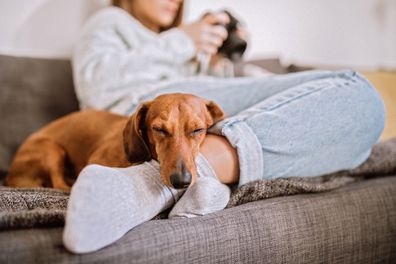How to transition your pet to the return to work
By Kate Rafferty|
For many workplaces, the beginning of March marks a gradual return to the office.
While the change might be welcome in some ways ! say 'so long' to all those tragic miscommunications email has brought us over the past few months ! in other ways, it can be a bit of a drag.
In quite pressing ways, the return to work is a big downer for our pets.
READ MORE: Kate and Camilla join forces to launch children's book club
READ MORE: Tips to minimise your pet's separation anxiety
After two years of having us at their beck and call, always up to take our pets for a walk, or curl up next to them on the couch, the return to work signals a new busy-ness in our lives as owners, which naturally means a lot less time for our pets.
During lockdowns, many pet owners have seen increased clinginess and even separation anxiety develop in their pets, which makes the return to work all the more stressful.
What if we start working from the office, only to have our pets absolutely freak out on us? From howling all day, to completely destroying our homes and gardens, every pet owner knows the capability of a distressed or bored pet.
Tips for a smooth return to work for you and your pup
According to PETstock ambassador and Dog Behaviourist Lara Shannon, the first place to start for any household with a "velcro dog" is to introduce some regular "independence training".
"Independence training is all about building up our dog's resilience for spending more time alone," says Shannon, adding that families "should be practising this as much as possible on the weekends, or even during the week as well."
One of Shannon's best tips for gearing your dog up to be more independent is to organise a few "separations" during the day.

For a daily dose of 9Honey, subscribe to our newsletter here
Elaborating, Shannon says that these "separations" can be made more enjoyable with long-lasting treats, such as a 'Kong" filled with a frozen soft dinner.
"Take them outside, feed them outside, and close the door.
"They can still see you, you might even still be in the home, but they're getting used to having distance from you," she says.
She advises that dogs have about three to five separations a day, to truly get them at ease with being alone.
Another good way to encourage this includes putting your dog's bed in a different room to you, or outside while you're at home with them.

READ MORE: Cat sprints to hear phone call from 'dad': 'I miss you'
"They'll feel comfortable that you're there but they're getting used to not always being by your side," explains Shannon.
She also advises that households who have to leave their dogs home alone all day will need to introduce independence training as soon as possible, in order to make the transition smooth and stress-free.
Naturally, as well as trying this light training, owners should also stock up on plenty of toys to keep pets occupied during the day.
Lara explains that practising these simple steps can also avoid more serious problems with pets, like the development of separation anxiety, which has affected quite a few pets over the pandemic period.
Tackling separation anxiety in dogs
Separation anxiety can present in dogs in a multitude of ways, and there are some common signs to look out for.
"Toileting inside the home, being destructive ! chewing things, digging, some dogs even go as far as chewing through doors ! not eating, even if there's food left out for them, all of those are signs of separation anxiety," says Shannon.
She adds: "It's really difficult to address and just expecting dogs to get used to it doesn't work, because it is basically just as real as the anxiety we experience as humans."
Shannon says that sometimes these symptoms can just be a signal your dog's bored, particularly if these unwanted behaviours are occurring much later in the day when they're tired.
READ MORE: Australia's longest-running drama Neighbours to end after 37 years

However, if owners notice the behaviours occur as soon as they leave their pet, then "serious steps need to be taken."
Shannon's best advice is for owners to consult their vet to see if the condition can be sorted out with some new household behaviours and training, or if medication is needed for particularly nervy pups.
"Medication can help dogs if they are particularly distressed and being destructive, and there's just no way that you can avoid leaving them alone all day," she says.
Shannon notes that there are some small ways to ease a dog's severe anxiety.
"All they're really looking for is human company, and there are ways to facilitate that if you can't be there.
"One idea is to see if a neighbour or dog walker can come in during the middle of the day to spend some time with your dog ! taking them for a walk or just sitting with them," she says.
Other ideas are to give your dog a walk in the morning and as soon as you get home from work, so they feel they're getting some attention and contact with you.
"In one case, a woman bought a mannequin and put her clothes on it, and her dog loved it. The dog sat on the sofa with the mannequin all day and was completely fine, after that," reveals Shannon.




